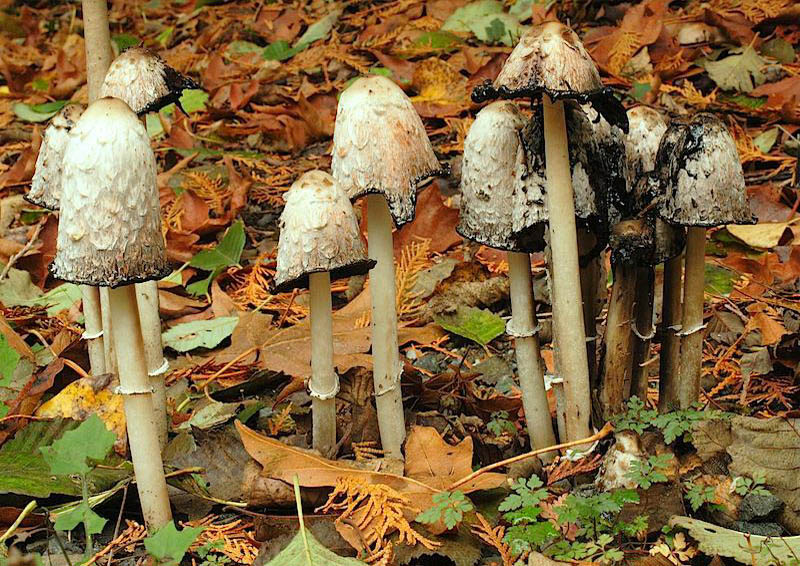
© Fred Rhoades
Danny’s DNA Discoveries – Coprinus of the PNW
by Danny Miller
|
|
Danny’s DNA Discoveries – Coprinus of the PNW
|
|
Introduction One of the most interesting results to come out of DNA studies was way back in 1994 (yes, they were sequencing way back then) when they found out that there are two families that create mushrooms that turn to ink, only distantly related to each other. The "shaggy manes" were closely related to the cultivated Agaricus portobello and button mushrooms, and everything else was most closely related to Psathyrella (you have to admit, sometimes they look like little inky caps that just don't turn to ink). Since the first Coprinus (inky cap) named was the shaggy mane, it got to keep the name Coprinus. All the others changed their genus and their family, with Psathyrella getting a promotion to having a family named after it, the Psathyrellaceae, to hold all the others. How could such odd behaviour evolve twice? A current theory is that when gills evolve to be too crowded together, the spores can't escape. Remember, spores of Basidiomycota are forcibly ejected from the gills, they don't just "fall off". If the gills are too close together the spore will be thrown against the neighbouring gill, which is no good. That puts pressure to "evolve or die" another spore dispersal mechanism, and dissolving into ink was a solution to getting the spores dispersed, albeit as a liquid. You can fill a fountain pen and write or draw with mushroom ink, and like squid ink, it may be edible. I don't know of any dangerously poisonous inky caps, only some that make you very sick if eaten near the same time you consume alcohol. Did you know that there are more than a half dozen different species of shaggy mane in the PNW? Did you know that the PNW is one of the places in the world where shaggy manes have been most studied, and that almost every single one of the species I talk about below, besides the common, universal shaggy mane Coprinus comatus var comatus, have their type (and only) collection described from Washington? Fred Van de Bogart described a number of species from WA in 1976 as part of his UW PhD requirements, but he found most of them only once and we had no known photographs of any of them. Not only that, few people have ever reported finding any of them since (probably because nobody has really been looking). Most are only known from Fred's original collections, but we have sequenced many of his types, and in many cases they are indeed real, distinct genetic species. Are they rare or have they always been overlooked because nobody knows about them? So please be on the lookout for anything except the common Coprinus comatus var comatus and get good collecting data and photos so we can properly document these mushrooms. Secotioid shaggy manes that may slightly turn to ink are Montagnea and Podaxis, genetically distinct enough to keep their own genera. Podaxis is not even in the Coprinaceae family, it is in the Agaricaceae s.s., which is puzzling to me. abundant common uncommon rare - colour codes match my Pictorial Key and are my opinions and probably reflect my bias of living in W WA. Rare species may be locally common in certain places at certain times. |
 Coprinus - click to expand Coprinus - click to expand
All inky caps have black or nearly black spores and might have free gills (though often initially attached, they secede, or break off the stem fairly easily). Coprinus, the ones covered on this page, can be told apart from the Psathyrella relatives by having truly free gills even from birth (like Agaricus) and gills that can turn an intermediate colour of pink as they mature before they turn dark (like Agaricus). They also have very scaly (shaggy) caps that are an unusual umbrella shape, often much taller than they are wide. There is a well developed ring on the stem, and a cottony thread running through their hollow stem attached at both ends. Microscopically, sterile cystidia are only present on the gill edges and nowhere else (they have cheilocystidia but no pleurocystidia). |
 Montagnea and Podaxis - click to expand Montagnea and Podaxis - click to expand
Secotioid inky caps do deserve their own genera. Montagnea is a sister genus to Coprinus. Podaxis is close to Agaricus. Neither deliquesce appreciably but only occasionally. |